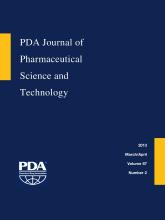Research ArticleResearch
Sustained Delivery of Amphotericin B and Vancomycin Hydrochloride by an Injectable Thermogelling Tri-Block Copolymer
Elham Khodaverdi, Arsalan Akbari, Farnaz Sadat Mirzazadeh Tekie, Seyed Ahmad Mohajeri, Gholamhossein Zohuri and Farzin Hadizadeh
PDA Journal of Pharmaceutical Science and Technology March 2013, 67 (2) 135-145; DOI: https://doi.org/10.5731/pdajpst.2013.00908
Elham Khodaverdi
1Department of Pharmaceutics, School of Pharmacy, Mashhad University of Medical Sciences, Mashhad, Iran;
3Targeted Drug Delivery Research Center, School of Pharmacy, Mashhad University of Medical Sciences, Mashhad, Iran;
Arsalan Akbari
1Department of Pharmaceutics, School of Pharmacy, Mashhad University of Medical Sciences, Mashhad, Iran;
3Targeted Drug Delivery Research Center, School of Pharmacy, Mashhad University of Medical Sciences, Mashhad, Iran;
Farnaz Sadat Mirzazadeh Tekie
5Department of Pharmaceutics, School of Pharmacy, Tehran University of Medical Sciences, Tehran, Iran
Seyed Ahmad Mohajeri
1Department of Pharmaceutics, School of Pharmacy, Mashhad University of Medical Sciences, Mashhad, Iran;
3Targeted Drug Delivery Research Center, School of Pharmacy, Mashhad University of Medical Sciences, Mashhad, Iran;
Gholamhossein Zohuri
4Department of Chemistry, Faculty of Science, Ferdowsi University, Mashhad, Iran; and
Farzin Hadizadeh
2Biotechnology Research Center, School of Pharmacy, Mashhad University of Medical Sciences, Mashhad, Iran;

References
- 1.↵
- Lin C.-C.,
- Metters A. T.
- 2.↵
- Gupta P.,
- Vermani K.,
- Garg S.
- 3.↵
- Kim S. W.,
- Bae Y. H.,
- Okano T.
- 4.↵
- He C.,
- Kim S. W.,
- Lee D. S.
- 5.↵
- 6.↵
- Khodaverdi E.,
- Rajabi O.,
- Farhadi F.,
- Jalali A.,
- Mirzazadeh Tekie F. S.
- 7.↵
- Klouda L.,
- Mikos A. G.
- 8.↵
- Adams M. L.,
- Lavasanifar A.,
- Kwon G. S.
- 9.↵
- Park J. S.,
- Woo D. G.,
- Sun B. K.,
- Chung H.-M.,
- Im S. J.,
- Choi Y. M.,
- Park K.,
- Huh K. M.,
- Park K.-H.
- 10.↵
- 11.↵
- Wei X.,
- Gong C.,
- Gou M.,
- Fu S.,
- Guo Q.,
- Shi S.,
- Luo F.,
- Guo G.,
- Qiu L.,
- Qian Z.
- 12.↵
- 13.↵
- Gou M.,
- Zheng L.,
- Peng X.,
- Men K.,
- Zheng X.,
- Zeng S.,
- Guo G.,
- Luo F.,
- Zhao X.,
- Chen L.,
- Wei Y.,
- Qian Z.
- 14.↵
- 15.↵
- Gong C.,
- Shi S.,
- Dong P.,
- Kan B.,
- Gou M.,
- Wang X.,
- Li X.,
- Luo F.,
- Zhao X.,
- Wei Y.,
- Qian Z.
- 16.↵
- Gong C.,
- Shi S.,
- Wu L.,
- Gou M.,
- Yin Q.,
- Guo Q.,
- Dong P.,
- Zhang F.,
- Luo F.,
- Zhao X.,
- Wei Y.,
- Qian Z.
- 17.↵
- Gong C. Y.,
- Shi S.,
- Dong P. W.,
- Yang B.,
- Qi X. R.,
- Guo G.,
- Gu Y. C.,
- Zhao X.,
- Wei Y. Q.,
- Qian Z. Y.
- 18.↵
- Moretton M. A.,
- Glisoni R. J.,
- Chiappetta D. A.,
- Sosnik A.
- 19.↵
- 20.↵
- Sosnik A.,
- Gotelli G.,
- Abraham G. A.
- 21.↵
- 22.↵
- Wu Q.,
- Zhou L.,
- Zhang D.,
- Song X.,
- Zhang G.
- 23.↵
- Barrett J. P.,
- Vardulaki K. A.,
- Conlon C.,
- Cooke J.,
- Daza-Ramirez P.,
- Evans E. G.,
- Hawkey P. M.,
- Herbrecht R.,
- Marks D. I.,
- Moraleda J. M.,
- Park G. R.,
- Senn S. J.,
- Viscoli C.
- 24.↵
- Espuelas M. S.,
- Legrand P.,
- Campanero M. A.,
- Appel M.,
- Chéron M.,
- Gamazo C.,
- Barratt G.,
- Irache J. M.
- 25.↵
- 26.↵
- van Etten E. W.,
- ten Kate M. T.,
- Stearne L. E.,
- Bakker-Woudenberg I. A.
- 27.↵
- Cafferkey M. T.,
- Hone R.,
- Keane C. T.
- 28.↵
- Liu C.,
- Bayer A.,
- Cosgrove S. E.,
- Daum R. S.,
- Fridkin S. K.,
- Gorwitz R. J.,
- Kaplan S. L.,
- Karchmer A. W.,
- Levine D. P.,
- Murray B. E.,
- Rybak M. J.,
- Talan D. A.,
- Chambers H. F.
- 29.↵
- 30.↵
- Lodise T. P.,
- Lomaestro B.,
- Graves J.,
- Drusano G. L.
- 31.↵
- Perkins H. R.
- 32.↵
- 33.↵
- Hirose K.,
- Marui A.,
- Arai Y.,
- Nomura T.,
- Inoue S.,
- Kaneda K.,
- Kamitani T.,
- Fujita M.,
- Mitsuyama M.,
- Tabata Y.,
- Komeda M.
- 34.↵
- 35.↵
- Mcclain J. B.,
- Bongiovanni R.,
- Brown S.
- 36.↵
- Jiang C. P.,
- Huang J. R.,
- Hsieh M. F.
- 37.↵
- Ma G.,
- Miao B.,
- Song C.
- 38.↵
- Miao B.,
- Song C.,
- Ma G.
- 39.↵
- 40.↵
- Hoogenboom R.,
- Schubert U. S.
- 41.↵
- Wiesbrock F.,
- Hoogenboom R.,
- Schubert U. S.
- 42.↵
- 43.↵
- Khodaverdi E.,
- Hadizadeh F.,
- Mirzazadeh Tekie F.,
- Jalali A.,
- Mohajeri S.,
- Ganji F.
- 44.↵
- 45.↵
In This Issue
PDA Journal of Pharmaceutical Science and Technology
Vol. 67, Issue 2
March/April 2013
Sustained Delivery of Amphotericin B and Vancomycin Hydrochloride by an Injectable Thermogelling Tri-Block Copolymer
Elham Khodaverdi, Arsalan Akbari, Farnaz Sadat Mirzazadeh Tekie, Seyed Ahmad Mohajeri, Gholamhossein Zohuri, Farzin Hadizadeh
PDA Journal of Pharmaceutical Science and Technology Mar 2013, 67 (2) 135-145; DOI: 10.5731/pdajpst.2013.00908
Sustained Delivery of Amphotericin B and Vancomycin Hydrochloride by an Injectable Thermogelling Tri-Block Copolymer
Elham Khodaverdi, Arsalan Akbari, Farnaz Sadat Mirzazadeh Tekie, Seyed Ahmad Mohajeri, Gholamhossein Zohuri, Farzin Hadizadeh
PDA Journal of Pharmaceutical Science and Technology Mar 2013, 67 (2) 135-145; DOI: 10.5731/pdajpst.2013.00908
Jump to section
Related Articles
- No related articles found.
Cited By...
- No citing articles found.





